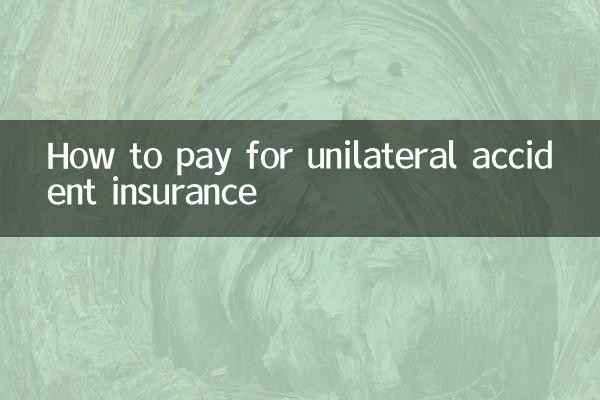How to pay for unilateral accident insurance
Recently, the issue of unilateral accident insurance claims has become a hot topic, and many car owners have questions about the claims process and precautions. This article will combine the hot content on the Internet in the past 10 days to provide you with a detailed analysis of the claims process, required materials and common questions for unilateral accident insurance, and provide structured data to help you understand quickly.
1. What is a unilateral accident?

A one-party accident is an accident caused by a single vehicle and does not involve other vehicles or third-party liability. For example, the vehicle hits a guardrail, tree, wall, or suffers self-damage due to operating errors, etc. The claims process for this type of accident is relatively simple, but attention to detail is still required.
2. Unilateral accident insurance claim settlement process
The following are the basic steps for a one-party accident claim:
| steps | Specific operations |
|---|---|
| 1. On-site processing | Stop the car immediately, turn on the double flashing lights, and place warning signs to ensure safety. |
| 2. Report a crime | Call the insurance company’s customer service number or report the incident through the APP and provide accident information. |
| 3. On-site inspection | The insurance company sends investigators to the scene to take photos and collect evidence, or requires the car owner to upload the photos himself. |
| 4. Loss determination | The insurance company assesses the amount of loss and confirms the repair plan. |
| 5. Submit materials | The car owner needs to provide relevant materials (see table below). |
| 6. Claims review | The insurance company reviews the materials and confirms the compensation amount. |
| 7. Compensation | The compensation will be paid into the car owner's designated account or directly to the repair shop. |
3. Materials required for unilateral accident claims
The following is a list of materials that car owners need to prepare:
| Material name | Remarks |
|---|---|
| insurance policy | Electronic or paper policies are available. |
| driver's license | Valid ID of the vehicle owner or driver. |
| driving license | Vehicle registration document. |
| accident proof | Accident determination letter issued by the traffic police (if necessary). |
| Maintenance invoice | A formal invoice must be provided after the repair is completed. |
| Bank account information | For receiving compensation. |
4. Frequently Asked Questions
1. Is it necessary to report a unilateral accident to the police?
Under normal circumstances, there is no need to report a unilateral accident to the police, but if it involves damage to public facilities (such as guardrails, street lights, etc.), you need to contact the traffic police to issue an accident certificate.
2. How is the claim amount determined?
The insurance company will determine the compensation amount based on the vehicle damage and insurance terms, and the car owner can choose to have the vehicle repaired at a 4S store or a cooperative repair shop.
3. How long is the time limit for claims settlement?
It usually takes 3-7 working days after the materials are complete. The specific time varies depending on the insurance company.
5. Things to note
1. Be sure to report the accident as soon as possible after the accident occurs. Delay in reporting may cause the claim settlement to be blocked.
2. When taking photos of the scene, the vehicle damage and accident environment must be clearly reflected.
3. If you have any objection to the loss assessment result, you can apply for re-assessment or third-party assessment.
Summary
Although the process of unilateral accident insurance claims is simple, car owners still need to pay attention to details to ensure that the materials are complete and the case is reported in a timely manner. Through the structured data and answers in this article, we hope to help you complete your claims efficiently and reduce unnecessary trouble.

check the details

check the details